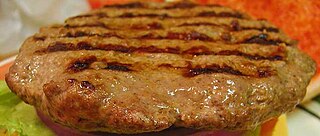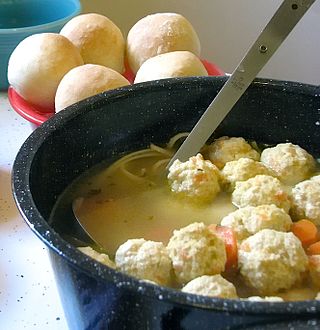Related Research Articles

English cuisine encompasses the cooking styles, traditions and recipes associated with England. It has distinctive attributes of its own, but is also very similar to wider British cuisine, partly historically and partly due to the import of ingredients and ideas from the Americas, China, and India during the time of the British Empire and as a result of post-war immigration.

Lasagna is a type of pasta, possibly one of the oldest types, made of very wide, flat sheets. Either term can also refer to an Italian dish made of stacked layers of lasagna alternating with fillings such as ragù, béchamel sauce, vegetables, cheeses, and seasonings and spices. The dish may be topped with grated cheese, which becomes melted during baking. Typically cooked pasta is assembled with the other ingredients and then baked in an oven. The resulting baked pasta is cut into single-serving square or rectangular portions.

The Forme of Cury is an extensive 14th-century collection of medieval English recipes. Although the original manuscript is lost, the text appears in nine manuscripts, the most famous in the form of a scroll with a headnote citing it as the work of "the chief Master Cooks of King Richard II". The name The Forme of Cury is generally used for the family of recipes rather than any single manuscript text. It is among the oldest extant English cookery books, and the earliest known to mention olive oil, gourds, and spices such as mace and cloves.

A cookbook or cookery book is a kitchen reference containing recipes.

Meatloaf is a dish of ground meat that has been combined with other ingredients and formed into the shape of a loaf, then baked or smoked. The final shape is either hand-formed on a baking tray, or pan-formed by cooking it in a loaf pan. It is usually made with ground beef, although ground lamb, pork, veal, venison, poultry, and seafood are also used, sometimes in combination. Vegetarian adaptations of meatloaf may use imitation meat or pulses.

Kebab, kabob, or kebap or kabab is roasted meat that originates from the Middle East and has been popularised by Iranian cuisine and Turkish cuisine. Many variants of the category are popular around the world, including the skewered shish kebab and the doner kebab with bread.

Mediterranean cuisine is the food and methods of preparation used by the people of the Mediterranean Basin. The idea of a Mediterranean cuisine originates with the cookery writer Elizabeth David's book, A Book of Mediterranean Food (1950) and was amplified by other writers working in English.

Kofta is a family of meatball or meatloaf dishes found in Balkan, Middle Eastern, North African, South Caucasian, South Asian and Central Asian cuisines. In the simplest form, koftas consist of balls of minced meat – usually beef, chicken, pork, lamb or mutton, or a mixture – mixed with spices and sometimes other ingredients. The earliest known recipes are found in early Arab cookbooks and call for ground lamb.

Tavukgöğsü is a Turkish milk pudding made with shredded chicken breast. It was a delicacy served to Ottoman sultans in the Topkapı Palace, and is now a well-known dish in Turkey.

A patty or burger is a flattened, usually round, serving of ground meat and/or legumes, grains, vegetables, or meat alternatives. Patties are found in multiple cuisines throughout the world.
More or less distinct areas in medieval Europe where certain foodstuffs dominated can be discerned. In the British Isles, northern France, the Low Countries, the northern German-speaking areas, Scandinavia and the Baltic the climate was generally too harsh for the cultivation of grapes and olives. In the south, wine was the common drink for both rich and poor alike while beer was the commoner's drink in the north and wine an expensive import. Citrus fruits and pomegranates were common around the Mediterranean. Dried figs and dates occurred quite frequently in the north, but were used rather sparingly in cooking.

A meatball is ground meat (mince) rolled into a ball, sometimes along with other ingredients, such as bread crumbs, minced onion, eggs, butter, and seasoning. Meatballs are cooked by frying, baking, steaming, or braising in sauce. There are many types of meatballs using different types of meats and spices. The term is sometimes extended to meatless versions based on vegetables or fish; the latter are also commonly known as fish balls.

Rabbit stew, also referred to as hare stew when hare is used, is a stew prepared using rabbit meat as a main ingredient. Stuffat tal-Fenek, a variation of rabbit stew, is the national dish of Malta. Other traditional regional preparations of the dish exist, such as coniglio all'ischitana on the island of Ischia, German Hasenpfeffer and jugged hare in Great Britain and France. Hare stew dates back to at least the 14th century, and was published in The Forme of Cury during this time as a recipe for stewed hare. Rabbit stew is a traditional dish of the Algonquin people and is also a part of the cuisine of the Greek islands. Hare stew was commercially manufactured and canned circa the early 1900s in western France and eastern Germany.
Teste de Turke is a dish of medieval cuisine, which had its origin according to today's knowledge in the Arab area. Through the cultural exchange after the Norman conquest of Sicily, which was formerly under Arab influence, this dish also reached England and France, where similar to Poume d'oranges, it appeared in various medieval Anglo-Norman manuscripts.
Utilis Coquinario is an English cookery book written in Middle English at the turn of the fourteenth century. The title has been translated as "Useful for the Kitchen". The text is contained in the Hans Sloane collection of manuscripts in the British Library and is numbered Sloane MS 468.
References
- 1 2 3 4 Adamson, M.W. (2013). Regional Cuisines of Medieval Europe: A Book of Essays. Garland Medieval Casebooks. Taylor & Francis. p. 27. ISBN 978-1-135-30868-1 . Retrieved June 15, 2017.
- ↑ Pullar, P. (1970). Consuming Passions: Being an Historic Inquiry Into Certain English Appetites. Little, Brown. p. 93. Retrieved June 15, 2017.
- ↑ Hieatt, C.B.; Nutter, T.; Holloway, J.H. (2006). Concordance of English Recipes: Thirteenth Through Fifteenth Centuries. G - Reference, Information and Interdisciplinary Subjects Series. ACMRS. p. 71. ISBN 978-0-86698-357-0 . Retrieved June 15, 2017.
- ↑ Walker, H. (1997). Food on the Move: Proceedings of the Oxford Symposium on Food and Cookery, 1996. Oxford Symposium on food & cookery. Prospect Books. p. 122. ISBN 978-0-907325-79-6 . Retrieved June 15, 2017.
- ↑ Austin, T. (1888). Two Fifteenth-century Cookery-books: Harleian Ms. 279 (ab. 1430), & Harl. Ms. 4016 (ab. 1450), with Extracts from Ashmole Ms. 1429, Laud Ms. 553, & Douce Ms. 55. Early English Text Society (Series).: Original series. Early English text society. p. 58. ISBN 9785876858115 . Retrieved June 15, 2017.